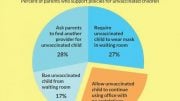
Childhood obesity is a growing concern in today’s society. It is defined as a condition where a child has an excessive amount of body fat, putting them at risk for various health problems. This health issue is caused by a combination of genetic, environmental, and lifestyle factors, such as unhealthy diets, lack of physical activity, and sedentary behavior. Childhood obesity can have severe impacts on a child’s physical and mental health, leading to conditions such as diabetes, heart disease, and low self-esteem.
The issue of childhood obesity is complex and demands complex solutions.
According to a recent study that charts the intricate pathways leading to childhood obesity for the first time, solely focusing on short-term solutions such as diet and exercise programs will not be enough to stem the rise of childhood obesity.
A study coordinated by the Charles Perkins Centre at the University of Sydney has discovered that children with parents who did not finish high school and who experience social disadvantage have a higher likelihood of being overweight or obese during their mid-adolescence. High school completion serves as a strong indication of socioeconomic status.
These factors were ‘on ramps’ which flow down to influence the body mass index (BMI) of parents, in turn providing immediate lifestyle impacts (diet, sedentary time) on a child’s risk of developing obesity.
Paediatrician Professor Louise Baur of the University of Sydney said the research explains why most current public health policies to prevent childhood obesity have had limited success.
“We tend to ignore the root causes of childhood obesity which include social disadvantage, and of course, this is not something parents or children choose for themselves,” said Professor Baur, co-author from the University’s Charles Perkins Centre.
“While healthy eating and activity interventions are important, the solutions lie not just in the domain of health departments. We need to see many government departments working together to consider how to make structural changes to reduce social inequality if we want to change Australia’s current trajectory.”
Other interesting findings from the research include how different drivers of obesity play out at different life stages, particularly the influence of free time activity after the age of eight.
There are also different influences on how free time is spent and influenced for boys versus girls. For boys, more electronic gaming leads to less active free time. For girls, better sleep quality leads to longer sleep time and more active free time.
Obesity in children
Childhood obesity occurs when a child is significantly overweight for their age and height. It can lead to a higher risk of cardiovascular disease, insulin resistance, psychological effects and even premature death.
In Australia, 1 in 4 school-aged children and adolescents are affected by overweight or obesity, with 1 in 12 affected by obesity. It is more common in those living in regional and remote areas, those from lower socioeconomic areas, those from one-parent families, and those with a disability.
How was the study conducted?
The study, published in the journal BMC Medicine, drew on data from ‘Growing up in Australia: The Longitudinal Study of Australian Children,’ a nationally representative sample of over 10,000 Australian Children.
The team of leading scientists and clinicians—bringing together the fields of data science, biology, pediatrics, and public health—spent close to two years using state-of-the-art statistical modeling (Bayesian network modeling) and informed analysis to untangle a complex web of on-ramps and causal factors, many of which interplay.
Senior author Professor Sally Cripps of the University of Technology Sydney said the knowledge gained from this study is vital for policymakers moving forward and could not have been achieved without this diverse skill-set.
“This is a truly multidisciplinary piece of research. Data alone is never enough to uncover the complex set of interacting factors that lead to childhood obesity. But by combining the skills of mathematicians and computer scientists with obesity and nutritional experts we have been able to predict and model what has never been clearly articulated before – showing the complex interplay between multiple upstream, downstream, and causal factors, and how these play out over time for children and families,” said Cripps, Director of Technology at the Human Technology Institute.
Lead author and statistician Wanchuang Zhu, also of the University of Technology Sydney and an affiliate of the Charles Perkins Centre said: “To our knowledge, this is the first time anyone has used the advanced statistical network modeling to analyze the complex factors that lead to childhood obesity. It provides us with a much more complete picture.”
Key findings
- Childhood obesity is largely a by-product of socioeconomic status
- Parental high school levels (both paternal and maternal) serve as on-ramps to childhood obesity
- When children are aged 2 to 4 years the causal pathway is: socio-economic status/parental high school level -> parental BMI -> child BMI
- When children are aged 8 to 10 years an additional pathway emerged focused on how children spend their leisure time: parental high school level /socioeconomic status -> electronic games ->free time activity-> child BMC
- The upstream influences on free time activity were different in boys compared with girls.
- The strong and independent link between parents’ BMIs and childhood BMI suggests a biological link—high weight runs in families, and this is in part because of shared genes.
The work is a collaboration between scientists and clinicians from the University of Sydney, the University of Technology Sydney, and CSIRO – brought together by the Charles Perkins Centre, a research initiative committed to collaborative and multidisciplinary research to tackle obesity, diabetes, cardiovascular disease, and related conditions.
“This study is exactly why the Charles Perkins Centre was founded, to bring together people with special skill sets from different academic and clinical backgrounds to find new ways of thinking about and solving the most complex challenges of our time,” said Professor Stephen Simpson, Academic Director of the Charles Perkins Centre and Executive Director of Obesity Australia.
Reference: “Bayesian network modelling to identify on-ramps to childhood obesity” by Wanchuang Zhu, Roman Marchant, Richard W. Morris, Louise A. Baur, Stephen J. Simpson and Sally Cripps, 21 March 2023, BMC Medicine.
DOI: 10.1186/s12916-023-02789-8
The authors express sincere gratitude to the families who contributed their data and acknowledge the generous support of Paul Ramsay Foundation.
The study was funded by the Paul Ramsay Foundation, the National Health and Medical Research Council, and the National Health and Medical Research Council.









Sadly, about the only part they got right was: “Data alone is never enough to uncover the complex set of interacting factors that lead to childhood obesity.” Not actually all that complex, even the most competent and diligent “evidence-based” research on the largest of reliable data banks cannot indicate-for what I have personally experienced in conjunction with what I later learned. First, there is a kind of practically harmless individual nearly subclinical food (minimally) allergy reaction which, despite the efforts of Dr. Arthur F. Coca and myself, minimally, remains unrecognized, unresearched and unpracticed by mainstream medicine. Unfortunately for myself and many others, Dr. Coca’s (my) kind of allergies are easily turned chronic and deadly dangerous naturally (e.g., too little variety and/or too frequent dosing, minimally) and/or artificially (e.g., toxic food additives and/or forced feeding, minimally).
Ignorantly (?), as a now for-certain ‘illness-for-profit’ oriented genocidal leader, the US instigated the global obesity pandemic in 1980 with the FDA’s illegal and stupid approval of the expanded use of added ‘cultured-free’ (can cross the blood/brain barrier, as opposed to natural ‘protein bound’ which can’t) monosodium glutamate (MSG) with the so-called “Western Diet” going/gone global since. In terms of childhood obesity, the undiagnosed allergies/inappropriate-traditional diet are the root causes (e.g., sluggish metabolism preceding a more sedentary lifestyle), toxic food additives are aggravating factors and the whole problem is seriously exacerbated with excessive related/resultant expert/medical errors.
These studies are some of the biggest pieces of funded garbage.
Its down to socioeconomic status? We need to solve the equity problem to keep people from being fat?
Thats just funded garbage to make a case for more extreme socialism and communism.
I know many many poor people who grew up poor (me and my family, my wife and hers) and are not obese.
Being poor has nothing to do with it.
Eating unhealthy and not exercising has 90+% to do with it.
And you can eat healthy if you are poor.
Fresh veggies are actually not expensive.
It comes down to convenience, laziness, ignorance, and stupidity more than anything else.
And if grammar/grade schools did their jobs properly then the ignorance part shouldnt even be considered.
Wrong again, tennisguy. Check out the two sources below (minimally; many other), reread (read?) what I commented above from those new perspectives and see if it doesn’t help explain what appears to be so mysterious to so many. The fact of the matter is that most healthcare professionals (grammar/grade school teachers?) are allergy and FDA approved food poisoning ignorant and incompetent.
“MURDER BY INJECTION The Story of the Medical Conspiracy Against America” Eustace Mullins 1988 and “The Slow Poisoning of Mankind” A Report on the Toxic Effects of the Food Additive Monosodium Glutamate Presented by John Erb of Canada to the Joint FAO/WHO Expert Committee On Food Additives August 2006.